How much a 1909 VDB penny is worth depends on the condition of the coin and where it was minted. Philadelphia coins are typically worth between $12 and $20 in low circulated grades, and $23 to $30 in uncirculated condition. San Francisco coins, on the other hand, are worth more, with average condition coins fetching $400 to $1,000. Uncirculated coins in extremely fine condition can even reach $1,500 or more. As for proof coins, they are considered the most valuable, with even the lowest grades fetching at least $33,500.
The 1909 VDB penny is a rare coin worth collecting. It was the first penny to feature the image of Abraham Lincoln on the front, and it was designed by Victor David Brenner. The coins were released in late 1909, but many of them were later pulled from circulation because people didn’t like the design. As a result, there are not many pennies in existence today. If you’re lucky enough to find one in your change, make sure to hold on to it!
In this blog post, we will take a look at the value of a 1909 VDB penny. The 1909 VDB penny is worth more than face value because of its rarity and historical significance. So what is this penny worth? Let’s find out!
What Does VDB on a Penny Stand For?
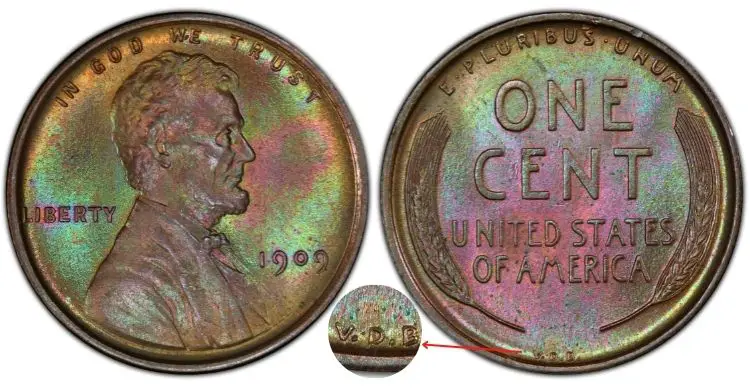
Do you ever wonder about the initials VDB that are stamped on some Lincoln wheat cents? These letters stand for the designer of the coin, Victor David Brenner. Brenner was a Lithuanian-born sculptor who emigrated to the United States as a child. He went on to have a successful career, designing everything from medals to government buildings.
In 1909, he was commissioned to create a new design for the Lincoln penny. His original design featured a portrait of Lincoln on the front and two wheat heads on the back. This design was used on all Lincoln pennies up until the 1950s, when it was replaced with the design featuring the Lincoln Memorial. So next time you see a VDB penny, take a moment to appreciate the work of this talented artist.
1909 VDB Penny Explained
The Lincoln penny was first introduced in 1909. The decision to put Lincoln on the penny was made in part because he was considered one of the most important presidents in American history, and in part because 1909 marked the 100th anniversary of his birth. The image of Lincoln on the penny is based on a photo taken by Mathew Brady in February 1864, just a few months before Lincoln was assassinated. The photo shows Lincoln at the end of a long day, and many have noted that it captures his weariness and resolve.
The 1909 VDB penny was designed by Victor David Brenner as a tribute to President Abraham Lincoln. However, many people believed that the initials VDB were too big and intrusive, and they caused an uproar when the coins were first released. As a result, the Mint decided to remove Brenner’s initials from the rest of the Lincoln cents.
What Does a 1909 VDB Penny Look Like?

The 1909 VDB penny is a very collectible coin, and it has a few distinctive features that make it easy to identify. The 1909 VDB penny is composed of 95% copper, 5% tin and zinc. It has a smooth edge and a diameter of 19.00 millimeters. The weight of the coin is 3.11 grams.
On the obverse, or front side, of the coin is a portrait of Abraham Lincoln. The legend “IN GOD WE TRUST” appears above his head, while the word “LIBERTY” and the date (1909) are inscribed as well. The reverse side of the coin features an image of two wheat stalks, with the legends “E PLURIBUS UNUM” and “ONE CENT”. The controversial initials “VDB” can be found at the bottom of the reverse, just above the coin’s rim. These initials stand for Victor D. Brenner, who designed the coin.
Mint marks, when present, can be found on the obverse side of the coin under the date. Mint mark “S” indicates the Lincoln wheat penny was struck in San Francisco, while no mint mark indicates the 1909 Lincoln wheat penny was struck in Philadelphia.
There are several types of the 1909 Lincoln Wheat penny
The Philadelphia mint’s VDB type featuring the designer’s initials
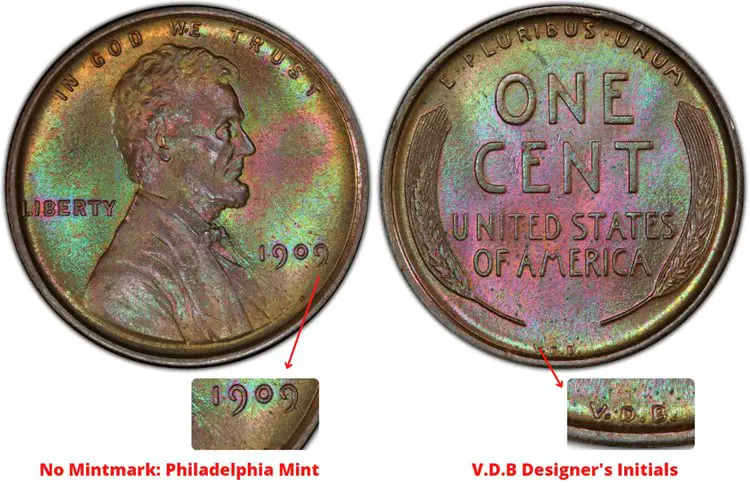
The Philadelphia-minted coins without initials
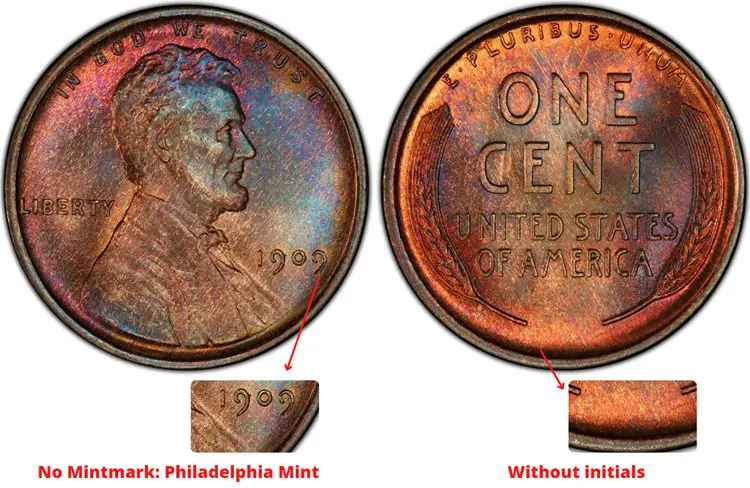
The VDB penny from the San Francisco mint featuring the designer’s initials
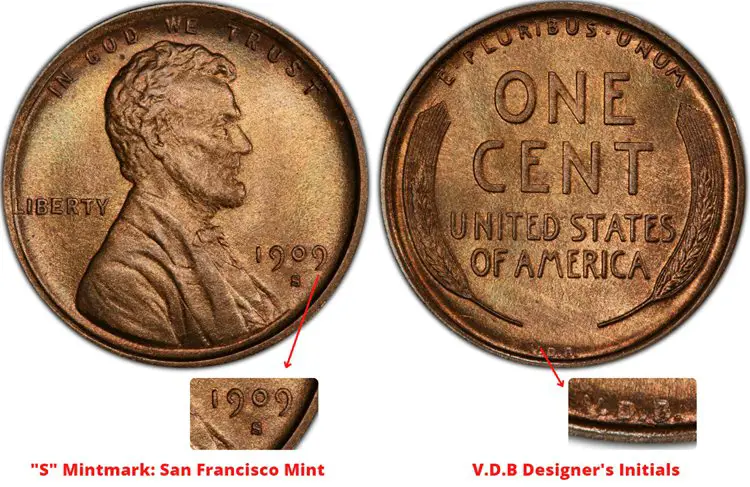
The 1909 S VDB without initials
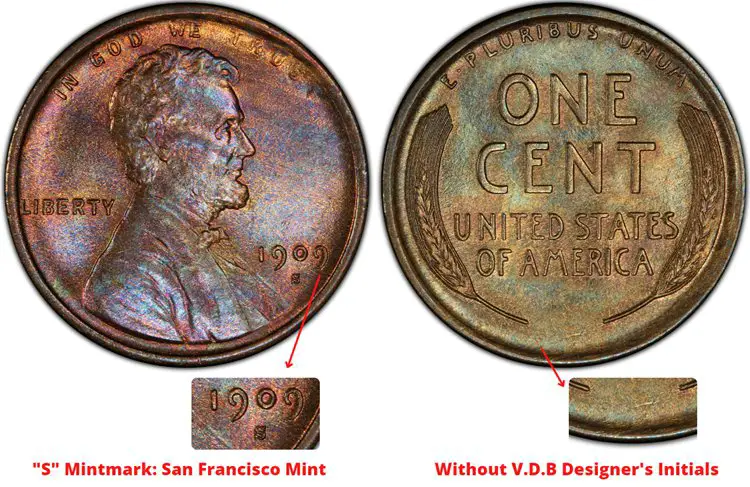
The double-struck S minting error from the San Francisco mint
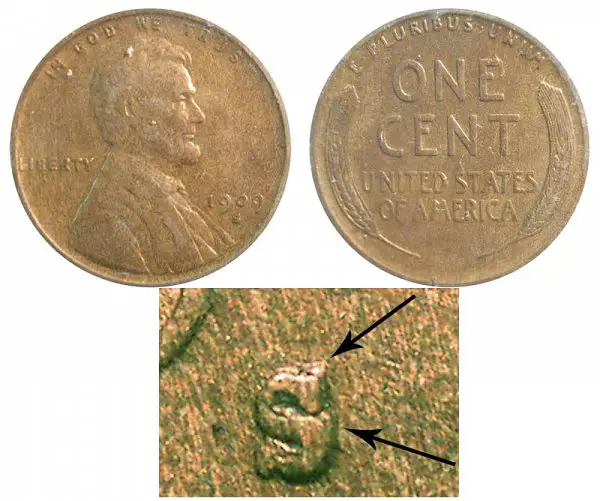
How Rare is a 1909 Wheat Penny?
The 1909 Wheat Penny is one of the most rare and coveted coins in circulation today. Just 484,000 of these coins were minted between Philadelphia and San Francisco, and survival estimates are about 50,000. Even less survived in pristine condition, making them highly sought-after by collectors. With such limited supply and high demand, a 1909 Wheat Penny can fetch a significant premium. So if you’re lucky enough to have one in your possession, be sure to hold on to it tightly!
How Much Is a 1909 Penny Worth
1909 wheat penny value depends on several factors, such as condition, mint mark and variety of the coin.
1909 P VDB Penny Value
1909 P VDB Penny Value |
|
| Quality | Value |
| low circulated grades | $12 to $20 |
| uncirculated condition | $23 to $30 |
| PR 66 | $33,500 |
| PR 67 | $160,000 |
The 1909 VDB Penny is a wheat penny that was minted in 1909 by the Philadelphia mint. There were 100,697,618 of these pennies minted, most of which have the VDB initials on them. These pennies are worth $12 to $20 in low circulated grades and $23 to $30 in uncirculated condition.
On the other hand, the 1909 VDB proof coins are highly coveted coins, and for good reason. Less than 200 proof pennies exist, making it a rare find. Even more rare is a 1909 VDB penny graded PR 66, which is worth an estimated $33,500. The most valuable 1909 VDB penny is graded PR 67, of which only a handful are known to exist. These coins can fetch upwards of $160,000 at auction. So if you’re lucky enough to find a 1909 VDB penny, be sure to have it authenticated by a professional before spending too much time daydreaming about your newfound fortune.
1909 S VDB Penny Value
1909 S VDB Penny Value |
|
| Quality | Value |
| Average condition | $400 to $1,000 |
| Extremely fine condition | $1,500 and more |
The 1909 S VDB penny is one of the most sought-after coins in the Lincoln series. San Francisco produced a total of 2,309,000 Lincoln pennies in 1909, but only 484,000 were struck with the VDB initials. Only a few hundred survived in good condition.
Even coins in average condition are worth $400 to $1,000, and uncirculated coins in extremely fine condition can reach $1,500 and more. The high price tag is due to the coin’s scarcity and its historical significance.
What is the Most Expensive 1909 VDB Penny Ever Sold?
The most expensive 1909 VDB penny ever sold was in incredible condition, graded MS 68 by the Professional Coin Grading Services. This is the only variant with this grade. The rich, satiny mint sheen is enhanced by the superb strike sharpness throughout. Each side is decorated with vibrant orange, copper, and gold hues, and there is no sign of any carbon spots. This particular coin sold for $56,400 in 2021. While this price tag may seem astronomical, it’s actually not surprising when you consider the condition of the coin and its unique status as the only one of its kind.
The second most expensive 1909 VDB penny ever sold is a proof coin graded PR66. This coin’s surfaces are simply remarkable, with margins that are cherry-red and a majority of each side being a vibrant, original orange-red. This piece was sold for $54,000 in 2021, making it one of the most valuable pennies on the market today.
1909 Lincoln Wheat VDB Error Coins
Coins are often minted to very exacting standards, with each coin being nearly indistinguishable from the next. However, there will always be a few coins that are produced with errors. These can range from minor imperfections to major defects, and they can occur at any stage of the production process. Many error coins are highly sought-after by collectors, as they can be quite valuable.
1909 S/S Error
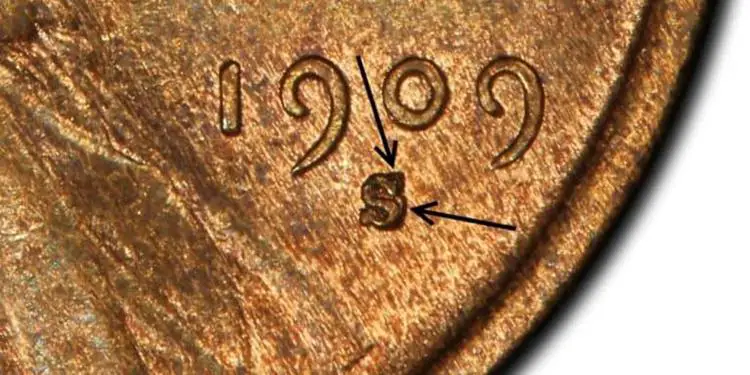
Shortly after production began, it was discovered that the mint mark on some coins (an S for the San Francisco Mint) was incorrectly struck. Instead of being minted horizontally, the first letter was minted vertically. Even though the error was corrected by striking the vertical letter over the existing wrong one, a small number of coins managed to escape detection and entered circulation. Today, these 1909 Lincoln Wheat VDB Error Coins are highly prized by collectors.
These coins can be worth 10% or more than a regular 1909 penny, with the record price for an MS 67 error coin reaching $24,000 at auction in 2018. If you’re lucky enough to have one of these rare coins, you could be sitting on a small fortune!
Double Die Obverse Error
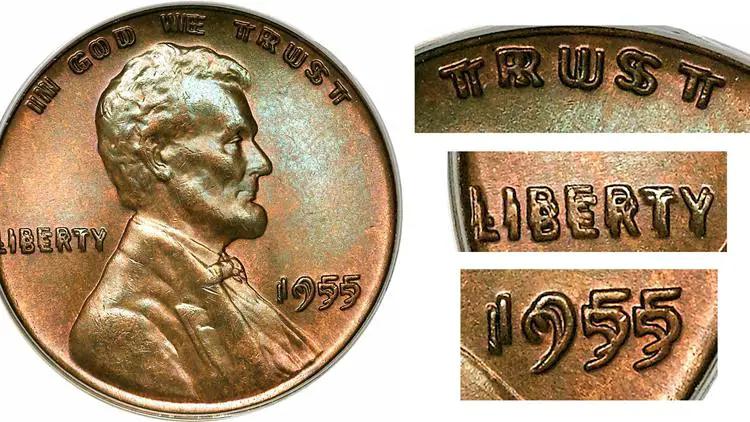
Photo: thesprucecrafts
The 1909 Lincoln Wheat VDB Double Die Obverse Error coin is a very rare and valuable coin. Double die errors happen when the design on one die is misaligned with the design on the other die. This can happen if the die isn’t properly aligned when it’s struck, or if the design on the die is defaced in some way.
Either way, it results in a very distinctive coin that is highly prized by collectors. The 1909 Lincoln Wheat VDB Double Die Obverse Error coin is one of the most famous and valuable examples of this type of error. It’s believed that only a handful of these coins exist, and they are worth a considerable amount of money. The record price for this type of error coin was $23,000 back in 2019. If you’re lucky enough to have one of these coins, you can be sure that it will be a valuable addition to your collection.
Factors That Influence the 1909 Penny Value
Collecting coins can be a fun and rewarding hobby, and 1909 pennies are a popular choice for many collectors. While the value of any coin is determined by a number of factors, including condition and rarity, changes in the overall economy can also have an effect on penny values. Let’s take a closer look at these factors.
Condition
Among collectors, the condition of a coin is one of the most important factors in determining value. A coin that is in pristine condition will be worth far more than a coin that is heavily worn or damaged. But what exactly does it mean for a coin to be in “good” condition? The Sheldon Grading scale is the most widely used method for assessing the condition of coins. The scale runs from 1 to 70, with 70 being a perfect coin.
Some common valuable grades for a 1909 penny include:
- MS 60 – Uncirculated coin with obvious flaws, usually an excessive amount of bag marks, a bad strike, or low shine.
- MS 63 – An uncirculated coin that is in better condition than coins in lower uncirculated grades.
- MS 64 – An uncirculated coin with a few light flaws or distracting markings. Most of the time, these coins have medium to above average eye appeal.
- MS 66 – Has a surface of above-average quality and a pristine sheen and no more than three or four small or obvious contact blemishes.
- MS 68 – A coin with this grade exhibits only four light scattered contact marks and a gorgeous sharp strike for the date and mint.
- PR 67 – Proof coin. Almost as struck, a few light flaws, extremely beautifully shine.
As you can see, the Sheldon Grading Scale is a valuable tool for coin collectors when it comes to determining the value and condition of a coin. If you think you might have a valuable coin in great condition, it’s helpful to have it graded by either PCGS or NGC.
Market Fluctuations
Generally speaking, coin prices tend to increase over time as they become more rare and difficult to find. However, this isn’t always the case, and the value of a coin can sometimes go down. This is usually due to changes in the economy or shifts in collector preference. The best way to find current coin prices is to look at recently sold coins. For example:
- A 1909 VDB Lincoln penny in brilliant uncirculated condition sold for around $70.
- A circulated 1909 VDB Lincoln wheat penny in a bad shape sold for $2,99.
- A 1909 VDB Lincoln wheat penny graded MS 65 sold for $199,99.
- A circulated 1909 S VDB wheat Lincoln penny sold for $1600!
Rarity
The value of a 1909 penny can be influenced by several factors, but one of the most important is rarity. The S mint mark is relatively rare, and coins with this mark are typically worth more than those without it. Proof coins are even rarer, and they are often highly prized by collectors. Additionally, a coin with an error like a double die obverse or S/S error can be worth a great deal of money.
How to Store Your 1909 VDB Penny
If you happen to have a 1909 VDB penny, then you might be wondering why it’s so important to store it properly. After all, it’s just an old coin, right? Wrong! The 1909 VDB penny is actually quite valuable, and its value is only going to increase as time goes on. Part of the reason for this is because there are so few of them in existence.
A well-preserved 1909 VDB penny can be worth hundreds or even thousands of dollars, while a damaged or worn coin will be worth far less. So, if you’re lucky enough to have one of these rare coins, be sure to take care of it!
There are a few simple steps you can take to ensure your coin stays in great condition for years to come:
- The best way to store the penny is in an acid-free plastic holder. This will help to prevent the penny from tarnishing.
- It is also important to keep the penny away from moisture, as this can damage the coin. The best location for storing the coin is in a cool, dry place. A safety deposit box at a bank or a home safe are both good choices.
- Avoid exposure to extreme temperatures and humidity, as this can damage the coin’s surface.
- When handling the coin, it is important to use gloves or a soft cloth to avoid damaging the surface of the coin.
FAQ
How many 1909 S VDB pennies are left?
While the exact number of 1909 S VDB pennies still in existence is unknown, experts believe that there are only around 5000 that remain in acceptable condition. Of those, only 3000 have been graded MS 65 or higher by professional coin grading organizations. The scarcity of the 1909 S VDB penny makes it a valuable coin for collectors, and examples in good condition can sell for thousands of dollars.
Why is the 1909 VDB penny rare?
The 1909 VDB penny is a very rare coin that was minted for only a brief period of time. There are several reasons for its scarcity. First, the U.S. Mint included the VDB initials of the designer, Victor D. Brenner, on the coin which caused a public outcry, and the mint quickly removed the initials. As a result, there are very few 1909 VDB pennies in existence. In addition, many of the coins that were minted were subsequently melted down by the mint, further reducing their number.
How many 1909s VDB were made?
In 1909, the United States Mint produced 484,000 pennies bearing the image of President Abraham Lincoln. In addition, 309,000 S VDB pennies were minted. The “S” indicates that these coins were minted at the San Francisco Mint, while the “VDB” refers to the initials of Victor D. Brenner, the designer of the coin.
How can you tell a fake 1909-S penny?
Take a look at the initials “VDB.” On a genuine coin, the V will be slightly higher than the D and B, and the central crossbar of the B will be slightly slanted. By familiarizing yourself with these key characteristics, you can help ensure that you don’t end up with a fake 1909-S penny.
What years are VDB pennies?
Only a certain percentage of 1909 pennies were minted with the VDB initials. The vast majority of pennies were minted without the VDB initials. The reason for this is that the U.S. Mint decided to remove the VDB initials from the penny after receiving complaints from the public. As a result, if you have a 1909 penny with the VDB initials, it is actually quite rare.
What is a matte proof penny?
A matte proof penny is a coin that has been given a special treatment to make it appear more dull and matte. The process involves first sandblasting the surface of the coin before coating it with varnish or enamel. This gives the coin a unique appearance that is different from the standard proof coins.
Final Thoughts
To wrap things up, how much is a 1909 VDB penny worth? It all depends on the condition of the coin and where it was minted. Philadelphia coins are typically worth between $12 and $20 in low circulated grades, while San Francisco coins can fetch $400 to $1,000. Uncirculated coins in extremely fine condition can even reach $1,500 or more. As for proof coins, they are considered the most valuable, with even the lowest grades fetching at least $33,500.
So, there you have it – a 1909 VDB penny can be worth quite a lot depending on its condition and provenance. With all this in mind, collectors should keep an eye out for 1909 VDB pennies in good condition, as they could be worth a considerable amount of money.
